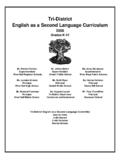Transcription of Harmonic Function Theory - Axler
1 Harmonic Function Theory second Edition Sheldon Axler Paul Bourdon Wade Ramey 26 December 2000. This copyrighted pdf le is available without charge only to individuals who have purchased a copy of Harmonic Function Theory , second edition. Please do not distribute this le or its password to anyone and do not post it on the web. 2001 Springer-Verlag New York, Inc. PDF Issues In your Adobe Acrobat software, go to the File menu, select Preferences , then General , then change the setting of Smooth Text and Images to determine whether this document looks bet- ter with this setting checked or unchecked. Some users report that the text looks considerably better on the screen with Smooth Text and Images unchecked, while other users have the opposite experience.
2 Text in red is linked to the appropriate page number, chapter, theorem, equation, exercise, reference, etc. Clicking on red text will cause a jump to the page containing the corresponding item. The bookmarks at the left can also be used for navigation. Click on a chapter title or section title to jump to that chapter or section (section titles can be viewed by clicking on the expand icon to the left of the chapter title). Instead of using the index at the end of the book, use Acrobat's nd feature to locate words throughout the book. Contents Preface ix Acknowledgments xi Chapter 1. Basic Properties of Harmonic functions 1. De nitions and Examples .. 1. Invariance Properties.
3 2. The Mean-Value Property .. 4. The Maximum Principle .. 7. The Poisson Kernel for the Ball .. 9. The Dirichlet Problem for the Ball .. 12. Converse of the Mean-Value Property .. 17. Real Analyticity and Homogeneous Expansions .. 19. Origin of the Term Harmonic .. 25. Exercises .. 26. Chapter 2. Bounded Harmonic functions 31. Liouville's Theorem .. 31. Isolated Singularities .. 32. Cauchy's Estimates .. 33. Normal Families .. 35. Maximum Principles .. 36. Limits Along Rays .. 38. Bounded Harmonic functions on the Ball .. 40. Exercises .. 42. v vi Contents Chapter 3. Positive Harmonic functions 45. Liouville's Theorem .. 45. Harnack's Inequality and Harnack's Principle.
4 47. Isolated Singularities .. 50. Positive Harmonic functions on the Ball .. 55. Exercises .. 56. Chapter 4. The Kelvin Transform 59. Inversion in the Unit Sphere .. 59. Motivation and De nition .. 61. The Kelvin Transform Preserves Harmonic functions .. 62. Harmonicity at In nity .. 63. The Exterior Dirichlet Problem .. 66. Symmetry and the Schwarz Re ection Principle .. 67. Exercises .. 71. Chapter 5. Harmonic Polynomials 73. Polynomial Decompositions .. 74. Spherical Harmonic Decomposition of L2 (S) .. 78. Inner Product of Spherical harmonics .. 82. Spherical harmonics Via Di erentiation .. 85. Explicit Bases of Hm (R n ) and Hm (S) .. 92. Zonal harmonics .. 94. The Poisson Kernel Revisited.
5 97. A Geometric Characterization of Zonal harmonics .. 100. An Explicit Formula for Zonal harmonics .. 104. Exercises .. 106. Chapter 6. Harmonic Hardy Spaces 111. Poisson Integrals of Measures .. 111. Weak* Convergence .. 115. The Spaces hp (B) .. 117. The Hilbert Space h2 (B) .. 121. The Schwarz Lemma .. 123. The Fatou Theorem .. 128. Exercises .. 138. Contents vii Chapter 7. Harmonic functions on Half-Spaces 143. The Poisson Kernel for the Upper Half-Space .. 144. The Dirichlet Problem for the Upper Half-Space .. 146. The Harmonic Hardy Spaces hp (H) .. 151. From the Ball to the Upper Half-Space, and Back .. 153. Positive Harmonic functions on the Upper Half-Space.
6 156. Nontangential Limits .. 160. The Local Fatou Theorem .. 161. Exercises .. 167. Chapter 8. Harmonic Bergman Spaces 171. Reproducing Kernels .. 172. The Reproducing Kernel of the Ball .. 176. Examples in bp (B) .. 181. The Reproducing Kernel of the Upper Half-Space .. 185. Exercises .. 188. Chapter 9. The Decomposition Theorem 191. The Fundamental Solution of the Laplacian .. 191. Decomposition of Harmonic functions .. 193. B cher's Theorem Revisited .. 197. Removable Sets for Bounded Harmonic functions .. 200. The Logarithmic Conjugation Theorem .. 203. Exercises .. 206. Chapter 10. Annular Regions 209. Laurent Series .. 209. Isolated Singularities .. 210. The Residue Theorem.
7 213. The Poisson Kernel for Annular Regions .. 215. Exercises .. 219. Chapter 11. The Dirichlet Problem and Boundary Behavior 223. The Dirichlet Problem .. 223. Subharmonic functions .. 224. viii Contents The Perron Construction .. 226. Barrier functions and Geometric Criteria for Solvability .. 227. Nonextendability Results .. 232. Exercises .. 236. Appendix A. Volume, Surface Area, and Integration on Spheres 239. Volume of the Ball and Surface Area of the Sphere .. 239. Slice Integration on Spheres .. 241. Exercises .. 244. Appendix B. Harmonic Function Theory and Mathematica 247. References 249. Symbol Index 251. Index 255. Preface Harmonic functions the solutions of Laplace's equation play a crucial role in many areas of mathematics, physics, and engineering.
8 But learning about them is not always easy. At times the authors have agreed with Lord Kelvin and Peter Tait, who wrote ([18], Preface). There can be but one opinion as to the beauty and utility of this analysis of Laplace; but the manner in which it has been hitherto presented has seemed repulsive to the ablest mathematicians, and di cult to ordinary mathematical students. The quotation has been included mostly for the sake of amusement, but it does convey a sense of the di culties the uninitiated sometimes encounter. The main purpose of our text, then, is to make learning about har- monic functions easier. We start at the beginning of the subject, assum- ing only that our readers have a good foundation in real and complex analysis along with a knowledge of some basic results from functional analysis.
9 The rst fteen chapters of [15], for example, provide su - cient preparation. In several cases we simplify standard proofs. For example, we re- place the usual tedious calculations showing that the Kelvin transform of a Harmonic Function is Harmonic with some straightforward obser- vations that we believe are more revealing. Another example is our proof of B cher's Theorem, which is more elementary than the classi- cal proofs. We also present material not usually covered in standard treatments of Harmonic functions (such as [9], [11], and [19]). The section on the Schwarz Lemma and the chapter on Bergman spaces are examples. For ix x Preface completeness, we include some topics in analysis that frequently slip through the cracks in a beginning graduate student's curriculum, such as real-analytic functions .
10 We rarely attempt to trace the history of the ideas presented in this book. Thus the absence of a reference does not imply originality on our part. For this second edition we have made several major changes. The key improvement is a new and considerably simpli ed treatment of spherical harmonics (Chapter 5). The book now includes a formula for the Laplacian of the Kelvin transform (Proposition ). Another ad- dition is the proof that the Dirichlet problem for the half-space with continuous boundary data is solvable (Theorem ), with no growth conditions required for the boundary Function . Yet another signi - cant change is the inclusion of generalized versions of Liouville's and B cher's Theorems (Theorems and ), which are shown to be equivalent.







